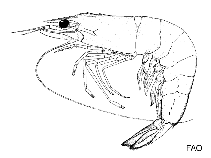Advertisement
Penaeus indicus Milne-Edwards, 1837
Indian white prawn
country information
Common names:
[No common name]
Occurrence:
Salinity:
Abundance: | Ref:
Importance: | Ref:
Aquaculture: | Ref:
Regulations: | Ref:
Uses: no uses
Comments:
National Checklist:
Country Information:
National Fisheries Authority:
Occurrences: Occurrences Point map
National Database:
Occurrence:
Salinity:
Abundance: | Ref:
Importance: | Ref:
Aquaculture: | Ref:
Regulations: | Ref:
Uses: no uses
Comments:
National Checklist:
Country Information:
National Fisheries Authority:
Occurrences: Occurrences Point map
National Database:
Common names from other countries
Classification / Names Common names | Synonyms | Catalog of Fishes (gen., sp.) | ITIS | CoL | WoRMS
Environment: milieu / climate zone / depth range / distribution range Ecology
Benthic; brackish; depth range 0 - 90 m (Ref. 8), usually 0 - 10 m (Ref. 110177). Tropical, preferred 27°C (Ref. 107945); 30°N - 31°S, 30°E - 168°E
Distribution Countries | FAO areas | Ecosystems | Occurrences | Introductions
Indo-Pacific: From northeast Africa to south China, Malaysia, Indonesia and north Australia. Introduced in southeast Africa.
Length at first maturity / Size / Weight / Age
Maturity: Lm 12.2, range 4 - 3.9 cm Max length : 20.5 cm TL male/unsexed; (Ref. 119750); 23.5 cm TL (female); common length : 17.0 cm TL male/unsexed; (Ref. 8); max. published weight: 35.00 g (Ref. 116487)
Short description Morphology
Uniformly glabrous carapace and abdomen. Hepatic and antennal spines on the carapace but no orbital spine. Sigmoidal curved rostrum is armed with 7 or 8 dorsal and 5 or 6 ventral teeth. Telson with no lateral spine. Shallow convexed rostral crest; adrostral carina reaches epigastric teeth; well-defined gastro-orbital carina, which occupies 2/3 distance between hepatic spine and margin of carapace. Color: in life, same as P. merguiensis but slightly more greyish or dull green. Antennal flagellum is yellow or greenish yellow. Posterior half of uropods is yellowish.
Minimum depth range based on occurrence (Ref. 110177). To be replaced with a better reference. Juveniles are found in mangrove creek-inlets, intertidal mud flats and far inshore waters (Ref. 121464). Prefers sand or mud bottom and can tolerate high salinity (Ref. 10). Adults live in marine environment and juveniles live in estuarine environment (Ref. 8).
Life cycle and mating behavior Maturity | Reproduction | Spawning | Eggs | Fecundity | Larvae
Members of the order Decapoda are mostly gonochoric. Mating behavior: Precopulatory courtship ritual is common (through olfactory and tactile cues); usually indirect sperm transfer.
Main reference
References | Coordinator | Collaborators
Holthuis, L.B. 1980. (Ref. 8)
IUCN Red List Status
(Ref. 130435: Version 2024-2)
CITES status (Ref. 108899)
Not Evaluated
CMS (Ref. 116361)
Not Evaluated
Human uses
Fisheries: commercial
FAO - Aquaculture: production, species profile; Fisheries: landings, species profile | FishSource | Sea Around Us
Tools
More information
Internet sources
BHL | BOLD Systems | CISTI | DiscoverLife | FAO(Aquaculture: species profile; Fisheries: species profile; publication : search) | GenBank (genome, nucleotide) | GloBI | Gomexsi | Google Books | Google Scholar | Google | PubMed | Tree of Life | Wikipedia (Go, Search) | Zoological Record
Estimates based on models
Preferred temperature
(Ref. 115969): 25.5 - 29.1, mean 28.3 (based on 1134 cells).
Resilience
(Ref. 69278)
High, minimum population doubling time less than 15 months (K=1-4.75).
Prior r = 1.19, 95% CL = 0.79 - 1.79, Based on 7 data-limited stock assessments.




